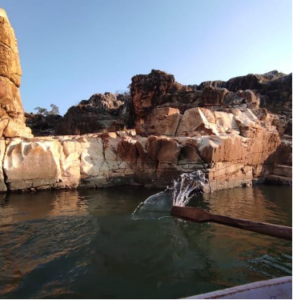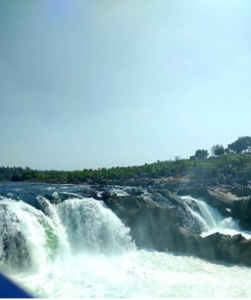
Jabalpur is a city that has always been enveloped in culture. For the unversed, this region was ruled by the Kalachuris, the Gondwanas, the Marathas, and finally the British before the independence and thus it saw various historic changes, and each of these rules has left a mark on the city. Renowned poets and authors like Subhadra Kumari Chauhan, Harishankar Parsai, and artist Beohar Rammanohar Sinha (known for his illustration of the Indian Constitution) are feathers in Jabalpur’s Cap. While the above factors sealed the city’s status as the cultural capital of Madhya Pradesh; the Narmada River has also graciously bestowed natural beauty that is older than rhyme and reason.
A couple of months back there was a celebration in Jabalpur as one such Narmada’s creation- Bhedaghat was placed in the Tentative List of UNESCO’s World Heritage list. It’s no meagre feat, and would capture more attention from tourists, thus in turn spells out development and job opportunities for the locals. The gorgeous sight of Narmada cascading through the pristine white rocks has never failed to mesmerize the tourists and locals alike. Such is the beauty of this site, that there is no child in Jabalpur who had never turned in an essay on the “Beauty of Marble Rocks”.However, apart from beauty, this place also has geological importance as the Bhedaghat-Lameta Ghat is the only example where Marble, Phyllite, BIF, Quartzite of the Mahakoshal group of Proterozoic age rocks exist together. The nominated location where Narmada falls into a 30-meter deep gorge is known as Dhuandhar waterfall (literally meaning the Cascade of Smoke). The river afterward flows for 3 km, in a narrow channel through the Dolomites a.k.a. Marble rocks. Though incomparable nationally, Victoria Falls Zimbabwe is similar to this scene in terms of river gorge albeit the difference in lithology is clear (River cuts through basaltic rocks in case of Victoria Falls).


Another cultural asset that this region hosts is the marble artworks. Whether it’s a farewell, birthday party, or just a souvenir, gift items made from marble rocks are town favorites. Household utensils, toys, earrings and pendants, you name it, bhedaghat has it. Even, the Shivlingam (representative of Hindu God Lord Shiva) for worshipping, is carved out of marble. There is a saying “Narmada Nadi ke Kankad mai rehte hai Bhagwan Shankar.’’ The Banalingas are a type of Shivlingam which naturally occurs in Narmada’s river bed. Legend has it that Tanjavure’s Brihadeeswara Temple houses one of the biggest Banalingam.
Yet there is a catch! The aforementioned aspects of Bhedhaghat make it a beloved picnic spot of Madhya Pradesh. As it is often the case with leisure sites, pollution follows it. There is an overwhelming number of anthropogenic activities like bathing, washing, wrapper dumping, and a few smartphones that can be caught submerged in the river. Unless people are schooling a fish about Instagram, it was pure carelessness on part of some Selfie-lover. Ignorant populace even walks over the exposed stratified rocks around the gorge.


Is Jabalpur somewhat careless about this potential Heritage site? On this, Mr. Partha Dass says “I have lived here [Jabalpur] for more than fifty years, I remember in my boyhood days there were numerous lakes here.” However, the shades of the blue lakes are a faded memory to many others like Mr. Dass. Today, these lakes have been filled up and in their stead Malls, sports complex, and other commercial buildings are built up. (Reference: https://www.patrika.com/jabalpur-news/colonies-known-the-name-of-ponds-1303955/)
It’s the same old sob story, but what if this similar leisurely treatment of Bhedaghat makes history repeat itself? Then it would not be the first instance of a heritage site being neglected in this town. No matter how aesthetically pleasing a location is, according to a 20-year archaeology student and a tourist “Sites that are treated as picnic spots automatically enter the limelight of mistreatment”. Heritage often entails something that we inherit from our ancestors. However, when we talk about Natural Heritage like Bhedaghat, it is borrowed from the next generation. It should be a common courtesy to not to carry food items on the site. There should be bathing and washing restrictions too. Even entry to vehicles should be limited. These small steps can make a significant difference as the preservation of these sites is the responsibility of the residents too; after all, self restraint is an act that the government or UNESCO cannot implement.
Amazing blog covering all aspects related to the site. Hope Bhedaghat remains as natural and beautiful as it is for the coming generations too.
Beautifully described the specifications of the place! Loved the way how you took the readers gradually looking into the beauty of the place to the threats it is facing. It’s precise and insightful. Way to go Shatabdi!
Very informative write up, Satabdi. Pictures included are vivid, Ramyani. Keep up the good work. Looking forward to more such articles in the future.
Great work!
Lovely!